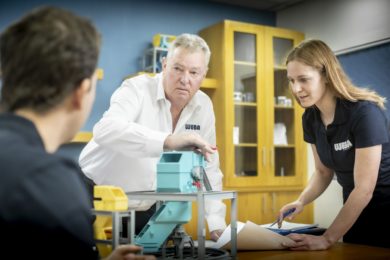When a coal mine in South Africa’s Mpumalanga province needed to replace its high maintenance conventional transfer chutes, it looked to Weba Chute Systems for the best custom-engineered design, the manufacturer says.
Weba Chute Systems is currently busy with designs that will pave the way for the retrofitting of over a dozen chutes at the mine. Eight of the units are silo discharge chutes, transferring coal from the operation’s run-of-mine feed to its coal processing plant. Another four chutes are to be replaced in the plant itself, while there is another chute located between two related feed conveyors.
“The main objective of the new bespoke chutes is to ensure stable supply to the plant, and from there to the nearby power station,” Dewald Tintinger, Weba Chute Systems’ Technical Manager and Designer, says. “The existing equipment is demanding too much maintenance, leading to unacceptable levels of downtime.”
The key to improved uptime and extended chute lifespan is the company’s flow control principles in its designs. The chutes in the plant, for example, must deal with oversize material of between 150 mm and 500 mm in size.
“Handling these large particles, chutes are exposed to high levels of impact and wear,” Tintinger says.“With the controlled flow philosophy of our Weba ‘cascade’ chute system, we control both the velocity and the impact.”
Commenting on other aspects of the custom designs, Tintinger says the transfer points will include features such as dead-boxes to create a lining from the mined material itself. This reduces the wear on the chute’s metal surfaces, extending the maintenance intervals and delivering more uptime. He highlights that the processing plant feeds the power station directly through two overland conveyors.
“This is a highly efficient model for delivering coal, but it demands that all elements of the materials handling system are working together,” he says. “Any disruption of coal flow caused by a transfer chute can cause costly delays, and render coal delivery unreliable.”
He notes that the mine has had good experience from the many other Weba chutes already installed at this operation, and is now standardising on this internationally accepted transfer point design for better results.
Designs and engineering are conducted in-house by Weba Chute Systems’ experienced team, using the latest software and finite element analysis tools for testing.
The design work is expected to be completed around the middle of 2022. Thereafter the mine will be in a position to contract the fabrication and installation work.










